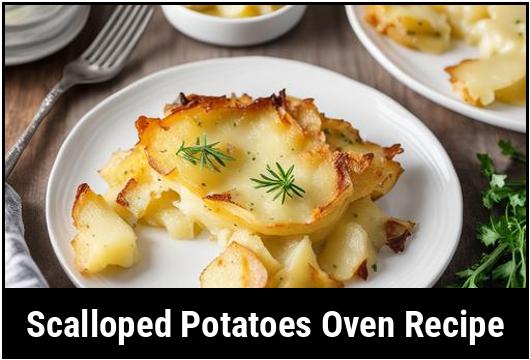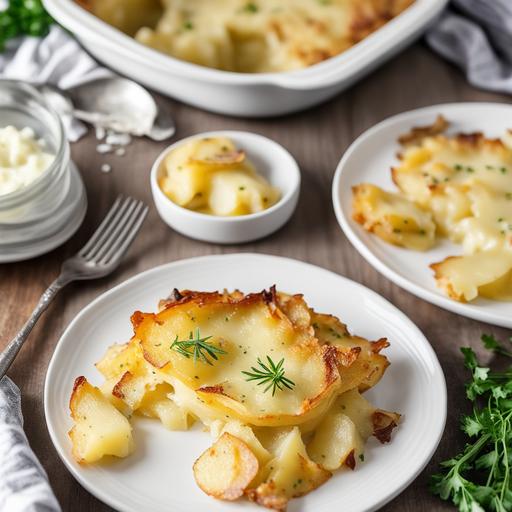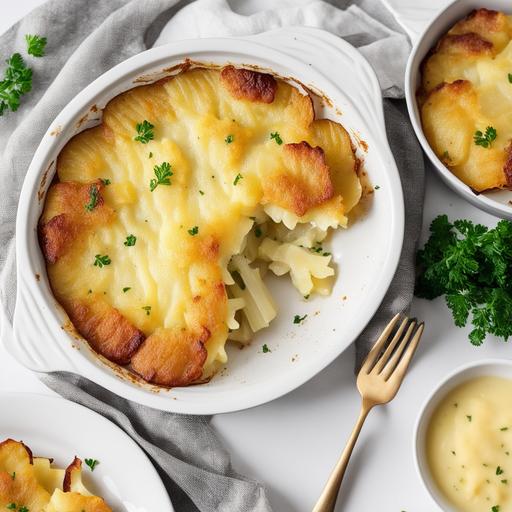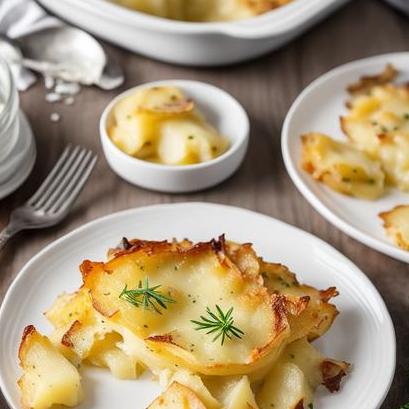
Scalloped Potatoes Oven Recipe: A Comprehensive Guide
Scalloped potatoes are a classic comfort food, beloved for their creamy texture and rich flavor. This dish, consisting of thinly sliced potatoes layered with a creamy sauce and baked to perfection, is a staple in many households. While there are countless variations of scalloped potatoes, one of the most popular methods involves baking them in the oven. In this article, we will explore the art and science of cooking scalloped potatoes in an oven, from selecting the right ingredients to achieving the perfect balance of flavors and textures.
Food Science Of Cooking Scalloped Potatoes In An Oven
Understanding the science behind cooking scalloped potatoes can help you achieve optimal results. The key components of this dish are the potatoes, the creamy sauce, and the cooking method.
Potatoes contain starch, which is responsible for their creamy texture when cooked. As the potatoes bake in the oven, the starches gelatinize, resulting in a soft and tender consistency. Slicing the potatoes thinly ensures even cooking and prevents them from becoming mushy.
The creamy sauce, typically made with a combination of milk or cream, butter, flour, and seasonings, binds the layers of potatoes together and adds richness to the dish. When baked, the sauce thickens and coats the potatoes, creating a luscious texture and flavorful coating.
Baking scalloped potatoes in the oven allows for gentle and even heat distribution, ensuring that the potatoes cook through evenly and the sauce thickens properly. The oven’s dry heat also helps to evaporate excess moisture, concentrating the flavors and creating a golden brown crust on top.
Choosing Ingredients
Selecting the right ingredients is crucial for making delicious scalloped potatoes. Here’s what you’ll need:
Potatoes
- Choose starchy varieties such as Russet or Yukon Gold potatoes, which have a creamy texture and hold their shape well when cooked.
- Look for potatoes that are firm and free from sprouts or green spots, which can indicate age or spoilage.
Creamy Sauce
- Use a combination of milk and heavy cream for a rich and creamy sauce. You can adjust the ratio to your preference, using more cream for a richer flavor.
- Butter adds richness and flavor to the sauce, while flour helps to thicken it. Be sure to use unsalted butter to control the saltiness of the dish.
- Seasonings such as salt, pepper, garlic powder, and herbs like thyme or rosemary can be added to enhance the flavor of the sauce.
Cheese (optional)
- While not traditional, cheese can be a delicious addition to scalloped potatoes. Choose varieties such as cheddar, Gruyère, or Parmesan for a flavorful topping.
- Grate the cheese finely to ensure even melting and distribution over the potatoes.
Preparing Ingredients

Proper preparation of the ingredients is essential for achieving the perfect texture and flavor in your scalloped potatoes.
Potatoes
- Wash and scrub the potatoes thoroughly to remove any dirt or debris.
- Peel the potatoes if desired, or leave the skins on for added texture and flavor.
- Using a sharp knife or a mandoline slicer, slice the potatoes thinly and uniformly, about 1/8 inch thick. This ensures even cooking and prevents the potatoes from being undercooked or overcooked.
Creamy Sauce
- In a saucepan, melt butter over medium heat.
- Whisk in flour to create a roux, cooking for 1-2 minutes until golden brown.
- Gradually whisk in milk and cream, stirring constantly to prevent lumps from forming.
- Cook the sauce until thickened, about 5-7 minutes, then season with salt, pepper, and any desired herbs or spices.
Assembly
- Preheat the oven to the desired temperature (more on that later).
- Grease a baking dish with butter or cooking spray to prevent sticking.
- Arrange a layer of sliced potatoes in the bottom of the dish, overlapping slightly.
- Pour a layer of creamy sauce over the potatoes, spreading it evenly with a spoon or spatula.
- Repeat the layers of potatoes and sauce until the dish is filled, ending with a layer of sauce on top.
- Optional: sprinkle grated cheese over the top layer for added flavor.
Optimal Oven Cooking Temperature & Timing
The key to perfectly cooked scalloped potatoes lies in the oven temperature and cooking time. Here’s what you need to know:
Oven Temperature
- Preheat the oven to 375°F (190°C) for a balance of gentle heat and caramelization on the edges of the potatoes.
- You can adjust the temperature slightly higher to 400°F (200°C) for a quicker cooking time and a more golden-brown crust, but be careful not to burn the edges.
Cooking Time
- Bake the scalloped potatoes uncovered for approximately 50-60 minutes, or until the potatoes are tender and the top is golden brown.
- To test for doneness, insert a sharp knife or a fork into the center of the dish. The potatoes should be soft and easily pierced.
Scalloped Potatoes Oven Recipe
Now that you have all the necessary information, let’s put it all together and make some delicious scalloped potatoes!
Ingredients
- 2 pounds (about 4-5 medium) Russet or Yukon Gold potatoes, thinly sliced
- 3 tablespoons unsalted butter
- 3 tablespoons all-purpose flour
- 2 cups whole milk
- 1 cup heavy cream
- Salt and pepper to taste
- Optional: 1 teaspoon garlic powder, 1 teaspoon dried thyme
- 1 cup grated cheese (cheddar, Gruyère, or Parmesan)
Instructions
- Preheat the oven to 375°F (190°C). Grease a 9×13 inch baking dish with butter or cooking spray.
- In a saucepan over medium heat, melt the butter. Whisk in the flour to create a roux, cooking for 1-2 minutes until golden brown.
- Gradually whisk in the milk and cream, stirring constantly until the sauce is thickened and smooth. Season with salt, pepper, garlic powder, and thyme, if using.
- Arrange a layer of sliced potatoes in the bottom of the prepared baking dish, overlapping slightly. Pour a layer of creamy sauce over the potatoes, spreading it evenly with a spoon or spatula.
- Repeat the layers of potatoes and sauce until the dish is filled, ending with a layer of sauce on top. Sprinkle grated cheese over the top layer, if desired.
- Cover the dish with aluminum foil and bake in the preheated oven for 30 minutes.
- Remove the foil and bake uncovered for an additional 20-30 minutes, or until the potatoes are tender and the top is golden brown.
- Let the scalloped potatoes cool for a few minutes before serving. Enjoy!
Cooking scalloped potatoes in the oven is a time-honored tradition that results in a delicious and comforting dish. By selecting the right ingredients, properly preparing them, and following the optimal oven temperature and timing, you can create scalloped potatoes that are creamy, flavorful, and perfectly cooked every time. Whether served as a side dish or a main course, these oven-baked scalloped potatoes are sure to be a hit with family and friends. Experiment with different seasonings, cheeses, and variations to make this classic recipe your own!
Doneness Checks

Scalloped potatoes, also known as potatoes au gratin, are a traditional dish consisting of thinly sliced potatoes layered with cream, butter, and cheese, then baked to golden perfection. The result is a decadent side dish or main course that pairs well with a variety of proteins or stands alone as a satisfying meal.
The key to achieving the perfect scalloped potatoes lies in the balance of ingredients and the proper cooking technique. Thinly sliced potatoes ensure even cooking and a creamy texture, while a combination of cream and cheese adds richness and flavor. Baking the dish in the oven allows the potatoes to soften and absorb the flavors of the cream mixture, resulting in a dish that is both tender and indulgent.
Determining when scalloped potatoes are done can be a bit tricky, as it depends on various factors such as the thickness of the potato slices and the temperature of the oven. However, there are several signs to look for to ensure that your scalloped potatoes are perfectly cooked.
1. Fork Test
One of the simplest ways to check for doneness is to insert a fork or knife into the center of the dish. The potatoes should be tender and easily pierced with minimal resistance. If the fork meets resistance or the potatoes feel firm, they may need more time in the oven.
2. Golden Brown Top
Another indicator of doneness is the color of the top layer of potatoes. When the dish is fully cooked, the top layer should be golden brown and slightly crispy. This indicates that the potatoes have caramelized and the dish is ready to be served.
3. Bubbling Cream
As the scalloped potatoes bake, the cream mixture will bubble and thicken, creating a creamy sauce that coats the potatoes. When the dish is done, the cream should be thick and bubbly, indicating that it has reduced and infused the potatoes with flavor.
4. Temperature Check
For added reassurance, you can use a food thermometer to check the internal temperature of the scalloped potatoes. The dish should reach an internal temperature of 165°F (74°C) to ensure that it is fully cooked and safe to eat.
Undercooking
Undercooking scalloped potatoes can result in a dish that is unpleasantly firm and lacks the creamy texture that is characteristic of this dish. To avoid undercooking, follow these tips:
1. Thinly Slice Potatoes
Thick potato slices will take longer to cook and may result in unevenly cooked potatoes. To ensure that your scalloped potatoes cook evenly, thinly slice the potatoes using a sharp knife or mandoline slicer.
2. Precook Potatoes
To speed up the cooking process, you can parboil the potato slices before layering them in the baking dish. Simply boil the slices in salted water for 5-7 minutes, then drain and pat them dry before assembling the dish.
3. Cover With Foil
Covering the baking dish with foil during the initial stages of baking helps to trap steam and heat, allowing the potatoes to cook through more quickly. Remove the foil during the last 10-15 minutes of baking to allow the top layer of potatoes to brown and crisp up.
4. Increase Oven Temperature
If you find that your scalloped potatoes are consistently undercooked, try increasing the temperature of your oven by 25°F (14°C). A higher temperature will help to cook the potatoes more quickly without sacrificing flavor or texture.
Overcooking
Overcooking scalloped potatoes can result in a dish that is mushy and lacking in flavor. To avoid overcooking, follow these guidelines:
1. Monitor Baking Time
Keep a close eye on your scalloped potatoes as they bake to prevent them from overcooking. Set a timer and check the dish periodically to gauge its progress. Once the top layer is golden brown and the potatoes are tender, remove the dish from the oven to prevent further cooking.
2. Avoid Excessive Liquid
Adding too much cream or cheese to the dish can result in an overly liquidy sauce that fails to thicken properly during baking. Use the recommended amounts of cream and cheese called for in the recipe, and avoid adding extra liquid unless necessary.
3. Adjust Baking Temperature
If you find that your scalloped potatoes are consistently overcooked, try lowering the temperature of your oven by 25°F (14°C). A lower temperature will allow the dish to cook more gently, preventing the potatoes from becoming mushy.
4. Rest Before Serving
Allowing the scalloped potatoes to rest for a few minutes before serving will help to firm up the dish and allow the flavors to meld together. This resting period also gives the sauce time to thicken slightly, resulting in a creamier texture.
Troubleshooting

Even with careful attention to detail, issues may arise when making scalloped potatoes. Here are some common problems and solutions:
1. Curdled Sauce
If your cream sauce appears curdled or separated after baking, it may be due to overheating or using high-fat dairy products. To salvage the dish, try whisking the sauce vigorously to recombine the ingredients. If this doesn’t work, you can try adding a small amount of cornstarch slurry to help thicken the sauce.
2. Burnt Top
A burnt top layer can occur if the oven temperature is too high or if the potatoes are sliced too thinly. To prevent this issue, cover the dish with foil during baking and reduce the oven temperature if necessary. You can also try adding a layer of breadcrumbs or cheese to the top of the dish to protect the potatoes from direct heat.
3. Raw Potatoes
If your scalloped potatoes are undercooked, it may be because the potato slices are too thick or the baking time is too short. To remedy this, thinly slice the potatoes and increase the baking time until they are tender. You can also try parboiling the potato slices before assembling the dish to ensure even cooking.
4. Watery Sauce
Excess moisture in the dish can result in a watery sauce that fails to coat the potatoes properly. To prevent this, be sure to pat the potato slices dry before layering them in the baking dish. You can also try reducing the amount of liquid called for in the recipe or adding a thickening agent such as flour or cornstarch to the cream mixture.
Recipe Variations
While traditional scalloped potatoes are delicious on their own, there are countless variations that allow you to customize the dish to suit your taste preferences. Here are a few ideas to inspire you:
1. Add Bacon
For a smoky twist on classic scalloped potatoes, try adding crispy bacon pieces to the cream mixture before baking. The salty flavor of the bacon pairs perfectly with the creamy potatoes and adds a delicious crunch to each bite.
2. Incorporate Herbs
Fresh herbs such as thyme, rosemary, or chives can add a burst of flavor to scalloped potatoes. Simply sprinkle the herbs between the layers of potatoes before baking, or stir them into the cream mixture for a more intense flavor.
3. Use Different Cheeses
Experiment with different types of cheese to create unique flavor combinations. Sharp cheddar, Gruyere, and Parmesan are all popular choices for scalloped potatoes, but feel free to get creative with your selection.
4. Add Vegetables
Incorporating vegetables such as spinach, broccoli, or caramelized onions into the dish can add color, texture, and nutrition. Simply layer the vegetables between the slices of potatoes before baking, or sauté them separately and stir them into the cream mixture.
Scalloped potatoes are a timeless dish that never fails to impress. With the right techniques and a bit of creativity, you can create a delicious and satisfying meal that is sure to please even the pickiest eaters. Whether you stick to the classic recipe or experiment with different variations, mastering the art of scalloped potatoes is sure to elevate your culinary skills and delight your taste buds.
Flavour Enhancement Tips
Scalloped potatoes, also known as potatoes au gratin, originate from French cuisine but have become a beloved dish in many countries around the world. The basic ingredients include potatoes, cream, cheese, and seasonings, though variations abound depending on regional preferences and personal tastes.
The beauty of scalloped potatoes lies in their simplicity. Thinly sliced potatoes are layered in a baking dish, interspersed with a creamy sauce, then baked until golden and bubbling. The result is a dish that’s creamy, cheesy, and comforting, with layers of tender potatoes enveloped in a rich, flavorful sauce.
Enhancing the flavor of scalloped potatoes can take them from delicious to extraordinary. Here are some tips to elevate the taste of your dish:
1. Season Each Layer
To ensure that every bite is bursting with flavor, season each layer of potatoes generously with salt, pepper, and any other herbs or spices you prefer. This ensures that the seasoning is evenly distributed throughout the dish.
2. Use Quality Ingredients
Choose high-quality potatoes, fresh herbs, and flavorful cheeses to enhance the overall taste of your scalloped potatoes. Yukon Gold or Russet potatoes work well for this dish, as they have a creamy texture and hold their shape when baked.
3. Infuse The Cream
Infusing the cream with aromatics such as garlic, thyme, or rosemary before adding it to the dish can add depth and complexity to the flavor profile. Simply heat the cream with your chosen aromatics until fragrant, then strain before using.
4. Experiment With Cheese
While classic scalloped potatoes often use Gruyere or cheddar cheese, don’t be afraid to experiment with different varieties such as Parmesan, Fontina, or goat cheese. Each cheese adds its own unique flavor profile to the dish.
5. Add Bacon Or Ham
For a heartier version of scalloped potatoes, consider adding cooked bacon or ham between the layers. The salty, savory flavor of the meat pairs perfectly with the creamy potatoes and cheese.
Texture Enhancement Tips

Achieving the perfect texture is key to making exceptional scalloped potatoes. Here are some tips to ensure your potatoes are tender, creamy, and delicious:
1. Slice Potatoes Thinly And Evenly
To ensure that the potatoes cook evenly and tenderize properly, slice them thinly and uniformly. A mandoline or sharp knife can help you achieve the perfect thickness, typically around 1/8 inch thick.
2. Pre-cook Potatoes Slightly
While not necessary, pre-cooking the sliced potatoes in simmering water for a few minutes can help them soften slightly before baking, resulting in a creamier texture. Be careful not to overcook them, as they will continue to cook in the oven.
3. Use Heavy Cream
For the creamiest texture, use heavy cream or a combination of milk and cream in your sauce. The high fat content helps create a luxurious texture and prevents the sauce from curdling during baking.
4. Don’t Overcrowd The Dish
Be sure to layer the potatoes evenly in the baking dish, avoiding overcrowding. This allows the heat to circulate evenly around each potato slice, ensuring they cook uniformly and develop a golden crust on top.
5. Let It Rest
Allowing the scalloped potatoes to rest for 10-15 minutes after removing them from the oven allows the sauce to thicken slightly and the flavors to meld together. This also makes it easier to slice and serve.
Cooking At Different Temperatures
The cooking temperature plays a crucial role in achieving the perfect texture and flavor in scalloped potatoes. Here’s how different temperatures can affect the outcome:
1. Low And Slow (325°F/160°C)
Baking scalloped potatoes at a lower temperature for a longer period results in a creamier texture and more developed flavors. This method allows the potatoes to cook gently and absorb the flavors of the sauce without becoming mushy.
2. Moderate Heat (375°F/190°C)
Baking at a moderate temperature yields tender potatoes with a slightly crisp top layer. This method is ideal for those who prefer a balance between creamy and crispy textures.
3. High Heat (400°F/200°C)
Baking at a higher temperature results in golden brown edges and a crispy top layer, while the potatoes remain tender inside. This method is perfect for those who enjoy a more pronounced contrast in texture.
Cooking Tips
Follow these additional cooking tips to ensure your scalloped potatoes turn out perfectly every time:
1. Grease The Baking Dish
To prevent the potatoes from sticking to the pan, be sure to grease the baking dish with butter or cooking spray before assembling the layers.
2. Cover With Foil
Covering the baking dish with foil during the initial stages of baking helps prevent the top layer of potatoes from browning too quickly. Remove the foil during the last 15-20 minutes of baking to allow the top to become golden and crispy.
3. Test For Doneness
Pierce the potatoes with a fork to test for doneness before removing them from the oven. They should be tender and easily pierced with little resistance.
4. Garnish Before Serving
Before serving, garnish the scalloped potatoes with fresh herbs such as parsley, chives, or thyme for a pop of color and flavor.
Serving Suggestions
Scalloped potatoes are a versatile dish that pairs well with a variety of main courses and side dishes. Here are some serving suggestions to complement your meal:
1. Serve With Roast Chicken
Pair creamy scalloped potatoes with succulent roast chicken for a classic comfort food meal that’s sure to please the whole family.
2. Pair With Grilled Steak
The rich and creamy texture of scalloped potatoes pairs beautifully with the bold flavors of a perfectly grilled steak. Add a side of steamed vegetables for a complete meal.
3. Enjoy With A Fresh Salad
Balance out the richness of scalloped potatoes with a crisp and refreshing salad dressed with vinaigrette. The combination of textures and flavors creates a well-rounded meal.
4. Serve As A Vegetarian Main
For a satisfying vegetarian meal, serve scalloped potatoes alongside a green salad or roasted vegetables. The creamy potatoes provide a hearty centerpiece that’s sure to satisfy.
Conclusion
Scalloped potatoes are a timeless classic that never fails to delight. With layers of tender potatoes enveloped in a creamy sauce and baked to perfection, this dish is the epitome of comfort food. By following the tips and techniques outlined in this article, you can create scalloped potatoes that are truly exceptional—flavorful, creamy, and utterly irresistible. Whether served as a side dish or a main course, scalloped potatoes are sure to become a favorite in your repertoire of recipes. So fire up your oven, gather your ingredients, and prepare to indulge in the deliciousness of homemade scalloped potatoes.
FAQS
What Are Scalloped Potatoes?
Scalloped potatoes are a classic dish made with thinly sliced potatoes that are layered with a creamy sauce, often with cheese, and baked in the oven until golden brown.
What Ingredients Do I Need For A Scalloped Potatoes Oven Recipe?
To make scalloped potatoes, you will need potatoes, butter, flour, milk, cheese (such as cheddar or Gruyere), salt, pepper, and any additional seasonings or herbs you prefer. Some recipes also call for onions, garlic, or breadcrumbs as optional ingredients.
How Do I Prepare The Potatoes For A Scalloped Potatoes Oven Recipe?
For a scalloped potatoes recipe, you will need to peel the potatoes and slice them thinly. You can use a sharp knife, a mandoline slicer, or even a food processor with the slicing attachment. It is important to aim for uniform slices to ensure even cooking. You can also soak the sliced potatoes in cold water for a few minutes to remove excess starch and prevent them from sticking together.
How Do I Make The Creamy Sauce For Scalloped Potatoes?
To make the creamy sauce for scalloped potatoes, start by melting butter in a saucepan over medium heat. Once melted, whisk in flour and cook for a couple of minutes until the mixture becomes frothy. Gradually add milk while continuing to whisk, and cook until the sauce thickens. At this point, you can mix in the cheese until melted and season with salt, pepper, and any other desired spices.
What Is The Baking Process For Scalloped Potatoes?
After layering the sliced potatoes and sauce in a baking dish, cover it with foil and bake in a preheated oven at a temperature around 350-375°F (175-190°C). The cooking time will vary depending on the thickness of your potato slices, but it usually takes around 45 minutes to an hour. To achieve a golden top, remove the foil during the last few minutes of baking and broil for a few minutes until the top is bubbly and lightly browned.


